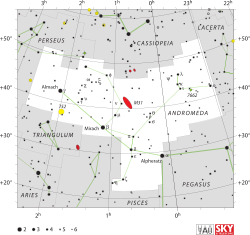Tau Andromedae
| Observation data Epoch J2000 Equinox J2000 |
|
|---|---|
| Constellation | Andromeda |
| Right ascension | 01h 40m 34.81645s |
| Declination | +40° 34′ 37.3742″ |
| Apparent magnitude (V) | +4.94 |
| Characteristics | |
| Spectral type | B5 III |
| U−B color index | -0.41 |
| B−V color index | -0.09 |
| Astrometry | |
| Radial velocity (Rv) | -14 km/s |
| Proper motion (μ) |
RA: +15.99 mas/yr Dec.: -23.76 mas/yr |
| Parallax (π) | 4.58 ± 0.25mas |
| Distance | 710 ± 40 ly (220 ± 10 pc) |
| Details | |
| Luminosity | 851 L☉ |
| Rotational velocity (v sin i) | 80 km/s |
| Other designations | |
| Database references | |
| SIMBAD | data |
Tau Andromedae (τ And, τ Andromedae) is the Bayer designation for a star in the northern constellation of Andromeda. It has an apparent visual magnitude of +4.94, which is bright enough to be viewed from dark suburban skies. From parallax measurements made during the Hipparcos mission, the distance to this star can be estimated as roughly 710 light-years (220 parsecs) from Earth. The brightness of this star is diminished by 0.24 in magnitude due to extinction caused by intervening gas and dust. It is approximately 681 light years from Earth.
The spectrum of this star matches a stellar classification of B5 III, with the luminosity class of III indicating that this is a giant star. It is radiating about 851 times the luminosity of the Sun.
In Chinese, 天大將軍 (Tiān Dà Jiāng Jūn), meaning Heaven's Great General, refers to an asterism consisting of τ Andromedae, γ Andromedae, φ Persei, 51 Andromedae, 49 Andromedae, χ Andromedae, υ Andromedae, 56 Andromedae, β Trianguli, γ Trianguli and δ Trianguli. Consequently, τ Andromedae itself is known as 天大將軍七 (Tiān Dà Jiāng Jūn qī, English: the Seventh Star of Heaven's Great General.).
...
Wikipedia

